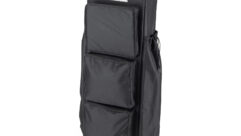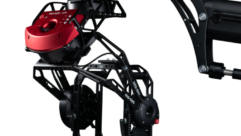KEEPING IT SAFE
Jul 1, 1999 12:00 PM,
Steve Filippini
You have just completed installing a security system for one of your morepublicly visible customers. You want to ensure that, in the future, he ishappy enough with the system to suggest your services to family, friendsand neighbors. It is at this point where you differentiate yourself fromthe dreaded trunk-slammer security providers-the people who sell securitysystems from their cars, make the deal, take the money and drive away. Youwill not be able to find them when something in the system needs servicing.It is essential that you approach the service call as you would anythingelse of importance to your business and your clients, carefully andthoroughly.
We will start with the main control panel. Every service call or scheduledmaintenance call should include a visit to the premise unit. Open theenclosure and visually inspect the contents. The wiring should be dressedaround the circuit board and bundled for neatness. Never route your wiringbehind or across the main circuit board. If there is any AC induction orelectrical noise present on the wiring, it can bleed off the wire andaffect the microprocessors that control the system. If you must routewiring behind the circuit board, be certain the insulation is not forcedagainst the solder pins of the circuit board. I have often seen a bundle ofwire behind the circuit board so large that the mounting screws had to bebacked off to avoid bowing the board.
If there are splices, make sure the ends of the splice are taped or capped.Tape does not always stay in place, and during the course of moving thingsaround, it may fall off. Take a minute to inspect the outer wire insulationfor cuts visually and check at the point the insulation was removed toexpose the individual leads inside the wiring jacket. Sometimes the wirestripper cuts deeper than expected, and you have exposed copper that canshort out or ground.
If the wiring inside the control panel enclosure is labeled, take yourinstaller out to lunch; he deserves it. Later, inspect the labels to see ifthey are attached properly to the wires. If they appear loose or torn,replace them. If the writing on the labels is faded or smeared, replacethem. This small act can mean the difference between a 10 minute servicecall or a two-hour seek-and-identify mission.
Take a screwdriver and check the tightness of each terminal on the premiseunit. Even if you do not have a wire under the terminal, check it. I haveseen control panels missing terminal screws because they loosen and falloff during maintenance calls and disappear. The reason the wires loosen isheat. Copper wires expand and contract with heat. Over a period of time,the wires will naturally loosen and create connections of high resistancethat will place the system in a state of instability. Also, verify that allof the mounting hardware for the circuit board and enclosure is secure andin place. If it is loose or missing, secure or replace it.
Locate the AC transformer that supplies power to the system. It should feelwarm, but not hot. If it is hot or causing discoloration on the wall behindit, verify that it is the right size for the application. The wires fromthe main control panel should be secure and not strained. If thetransformer has a faceplate mounting clip, use it. You do not want it tofall out when you need it the most. Take a second to verify that thetransformer is plugged into a 24-hour, non-switched outlet.
Next, check the back-up battery. Most systems will have a trickle-chargecharging circuit supplying the back-up battery with minimal current for aconstant level of charge. The easiest way to verify that the back-upbattery is fully charged and able to provide a reliable source of power isto remove the AC power supplying the system and meter the back-up batteryunder load. If your system uses a 12 VDC back-up battery, set yourvolt/ohm/amp meter to DC/Volts. Place the red lead of the meter to thepositive terminal of the battery. Place the black lead of the meter to thenegative terminal of the battery. When AC power is present, your meter willmeasure 13 VDC to 14 VDC. When AC power is removed, you will drop to around12.5 VDC to 12.8 VDC. This reading should stay there for an extended periodof time. If you remove AC power and the meter measures below 12 VDC in lessthan a minute, you have a faulty battery charging circuit or a weak cell inthe battery.
If you are concerned that the battery is not supplying the required back-upcurrent for an expected period of time, you may have to check the currentdraw of the system to verify that it is not exceeding system limitations.To do that, set your volt/ohm/amp meter to DC/Amps. Remove the red batterylead from the positive side of the back-up battery and attach the red leadof the meter to it. Attach the black lead of the meter to the positive sideof the battery. If your meter is configured to the correct setting, youwill be powering the system with the battery as it flows through the meter.If the current draw is larger than expected, you may have a peripheraldevice that is defective or a splice that is placing high resistance on thecircuit. Break up the system devices and track it down from there.
You have been doing this a long time, and you are gifted in the art ofremoving AC wires from the terminal strip without unplugging thetransformer. I cannot stress enough that unplugging the transformer is theonly safe way to remove AC power. That spark you see every time you removeor replace the wires is the result of a surge that will cripple theheartiest microprocessor. Even if the system appears to function perfectlyafter you have performed an AC-ectomy, you may have weakened the componentson the circuit board enough that they may fail next time around.
Some installers and service technicians meter each protection loop anddocument the resistance reading in the enclosure. That way, you can comparethe resistance readings you just took with those taken during theinstallation for comparison. That is handy when you suspect high resistanceas the cause of a false alarm.
One quick check before you move on. Does the system have a fire loop withfire detection devices wired to it? If you have wiring present at the fireloop terminals, make absolutely sure the end-of-line-resistor (EOLR) is notpresent at the same terminals. All fire loops need to be supervised againstloop breakage and power loss. If the EOLR is not installed properly, youmay not have a working fire loop after all.
That takes care of the main control panel. You can close it up and move tothe peripherals now. If the enclosure opens left to right, close theenclosure door and secure it by locking it or replacing the screw that heldit in place. If the enclosure opens from top to bottom, verify that you didnot leave any wire debris on the cover before you close it. If you do not,you will hear all of the copper trimmings dance on your circuit board asthey travel down to the bottom.
Was there a diagram of the premises in the enclosure when you got there?Was there a wiring list or meter reading sheet present upon your arrival?Many technicians in the field automatically put the paper in their backpocket without thinking. You may have a stack of them in your truck or athome. Your honest intentions to get them back to their rightful ownersslowly disappears as the stack gets larger.
One way I have attacked a system is to go to the front door and work my wayaround the house in a clockwise manner. Start with the perimeterprotection. Verify that the door contacts are secure and align properlywith the magnet. Some doors will warp or shift in their frames, moving themagnet away from the contact and weakening the magnetic field needed tokeep the contacts closed. Sliding glass doors usually have the contactsmounted in the frame. Check that they have not loosened or dropped to thelevel that closing the door damages them. Apply silicone if needed toresecure into place.
Windows are another matter. Some installers place the contacts and magnetsinside the frames and housings. Others mount the contacts and magnets onthe outside of the frame and glass. If the contacts and magnets are securedby double-back tape, apply a dab of silicone to each side of the contact ormagnet to reinforce the integrity of the device. This act of preventionwill reduce the chances of a false alarm when the tape dries out and thedevice falls away from its partner.
If you find a splice, confirm that the cover plate to the splice can issecure. If you need to check the splice, make sure that any splice caps andtape make it back to the ends of the exposed wires. The labels should belegible and secure. If there is a wiring diagram, remember to leave itthere when you are finished.
When you make your way back to the front door, start looking for interiordevices. Infrared motion sensors are most common. They usually hide in acorner somewhere. Make sure that the wiring at the terminals is secure.Make sure the device is secure to the wall and is not hanging in place byits wiring. Check for spiders or other pests that may have found a home inthe device. If you do not, they will come back and haunt you as a falsealarm.
Keep an eye out for system keypads, the primary focal point for thecustomer to interact with his system. Arm and disarm the system from eachkeypad. Activate any emergency functions that may be present. If the ditsyou hear while pressing keypad buttons seem distorted or muted, check thedevice for a buildup of dust, drywall dandruff or insects. Because thisdevice is used multiple times daily, make sure the keypad is securelymounted to the wall. If the keys stick, you might need to disassemble thekeypad and clean the molding around the buttons. Oils and finger jamresidue build up on the keys and slow down the return of the button to itsoriginal position. This will cause problems when the customer is tryingeither to disarm the system or to silence an alarm condition.
Check for smoke detectors. If they are wired to the system, pick one or twoand remove them from their mounting plate. This should result in a firetrouble condition. If it does not, find out why. Any compromise of the fireloop must result in an audible response from the main control. If younotice a build-up of dust at the detector, take a vacuum and suck out thedust from the sensing chamber. Check for pests as well. Verify that thedevice is securely mounted to the ceiling or wall and not supported by itswiring. Most detectors have a test spot built into the head of the device.A magnet placed at the test spot should result in a simulated fire alarmcondition. This should cause the main control panel to produce audiblewarnings that tell the customer to leave the location quickly.
Does the system have wireless devices? Ask the customer if he has panicbuttons or emergency activation devices. Activate each one to generate analarm condition. Check the batteries, and replace them if necessary.
If the system has wireless devices for the perimeter and interior points ofprotection, check the batteries in each device if they have not beenreplaced in a while. Refer to the manufacturer’s recommendation forreplacement suggestions. If possible, document the batteries replaced forfuture reference.
Finally, if the system has an external audible device, you need to check itas well. Arm the system and open a point of protection. Listen for theexternal horn or bell. If it is muffled, look for bird or hornet nests. Youhave probably already irritated them by setting off the alarm; let themcalm down before you deal with them. Otherwise, send your new assistant totake care of it.
If your system is monitored by a central or national monitoring center,take the time to send in a few signals. If, while your premise unit is incommunication with the monitoring center, you happen to lift thetelephonereceiver and hear a series of beeps and clicks, you need to correct theRJ31X wiring to provide line seizure. The only thing you should hear isdead air and the scratching of the customer’s pen on your service ticketthat states the system is operational and should be for many months to come.










